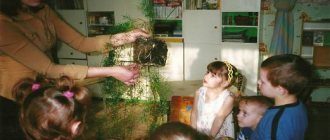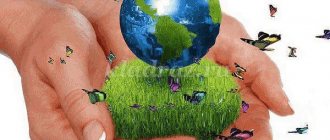Note 1
The goal of environmental education is the formation of a personality with a high level of environmental culture.
In the global understanding, the goal of environmental education is to educate a generation capable of navigating the real situation occurring in the environment, possessing all the necessary environmental knowledge and methods for solving various environmental problems.
The objectives of environmental education are to create effective conditions conducive to the harmonious ecological development of the child’s personality through joint cognitive, educational and environmental activities of children and the teacher.
Goals and objectives of environmental education in preschool educational institutions
Preschool age is a unique period in the formation and development of a child. A properly organized upbringing process has a productive effect on the overall development of the child and creates the prerequisites for his further upbringing and education.
Are you an expert in this subject area? We invite you to become the author of the Directory Working Conditions
The general goal of raising preschool children is the full, comprehensive and harmonious development of the child’s personality.
It is very difficult to identify a single goal of environmental education for preschool children, since environmental education is a continuous process that begins from preschool age and continues throughout life.
Note 2
According to the Federal State Educational Standard for Preschool Education, the goal of environmental education for preschool children is the implementation by preschool teachers of a continuous, purposeful, controlled process to develop an environmental culture in children.
Elements of ecological culture of preschool children are:
- respect for the environment
- sustainable knowledge about the surrounding world and the interconnection of all living things
- correct understanding of a “healthy lifestyle” (HLS)
- moral attitudes and ideas about environmental values
- emotional responsiveness to nature and its phenomena
- positive feelings and sensations from communication with the surrounding nature
- desire to explore and learn about the world around us
Finished works on a similar topic
Coursework The purpose and objectives of environmental education 440 ₽ Abstract The purpose and objectives of environmental education 280 ₽ Examination The purpose and objectives of environmental education 200 ₽
Receive completed work or specialist advice on your educational project Find out the cost
The goal of environmental education of preschool children, specified in the Federal State Educational Standard for Preschool Education, is achieved by solving its main tasks:
- Educational objectives:
- formation of a holistic system of knowledge about current environmental problems of the world
learning ways to solve environmental problems
- acquisition of knowledge on the prevention of environmental problems
- Educational tasks:
- formation of motives, habits and needs for environmental behavior
formation of a healthy lifestyle throughout life, a negative attitude towards bad habits
- development of the need for a healthy lifestyle and compliance with environmental rules of behavior
- Developmental tasks:
- development of a system of theoretical and practical knowledge, skills and abilities aimed at studying and assessing the state of the environment
development of skills to preserve and improve the state of the environment.
Ecological-subcultural practices in environmental education of preschool children.
Ecological-subcultural practices in environmental education of preschool children.
Dunaeva Yulia Alexandrovna
teacher
MBDOU kindergarten "Solnyshko"
Sechenovsky district
Nizhny Novgorod Region
Intensive educational work to develop environmental consciousness among the population begins in kindergarten - in the first link of the system of continuous environmental education.
Preschool childhood is the initial stage of the formation of a person’s personality and his value orientations in the world around him. During this period, a positive attitude towards the man-made world, oneself and the people around him is formed. The basis of environmental education is the formation in a child of a consciously correct attitude towards the natural objects that surround him and with which he becomes acquainted in preschool childhood.
Children's consciously correct attitude towards nature is based on their sensory perception, emotional attitude, knowledge of the characteristics of life, growth and development of individual living beings, some biocenoses, knowledge of adapted dependencies on environmental factors, relationships within natural communities (food connections). The conscious nature of the relationship is manifested in the fact that children themselves can explain the situation or understand the adult’s explanation. They can independently or with the help of an adult identify individual labor actions, understanding the situation and knowing the needs of a living being, which are aimed at preserving and improving the lives of animals and plants.
The process of developing a consciously correct attitude towards nature is accompanied by certain forms of child behavior, which serve as criteria for assessing his environmental education (ecological culture).
Ecological culture is a set of views on nature, a conscious attitude towards it, which is reflected in human behavior and all of his practical activities.
The “repository” of traditional ecological culture is the ecological subculture of children.
To date, various aspects of children's subcultural characteristics are presented in the studies of V.V. Abramenkova, M.A. Kozlovskaya, E.Yu. Kopeikina, E.E. Sapogova, E.O. Smirnova and R.E. Radeva, M.V. Osorina. The meaning and significance of childhood and children's subculture as a socio-historical phenomenon are considered by A. Barkan, M.D. Donaldson, W.T. Kudryavtsev, V.D. Shadrikov and others.
The ecological subculture as a form of existence is described by A.D. Kleshchev, and G.P. Sikorskaya sees the ecological subculture as an educational system complex. The ecological subculture of Childhood and the child’s self-development in it is studied by V.A. Zebzeeva.
The main pedagogical condition contributing to the formation of an ecological subculture of children in the preschool education system is the use of environmental and subcultural practices of Childhood.
Ecological-subcultural practices are situational, autonomous, independent, initiated by adults, peers or the child himself, the acquisition and repetition of various cultural experiences of communication and interaction with nature in various groups, teams, communities and social structures - with adults, peers, younger or older children . This is also the development of positive life experiences of empathy, goodwill, love, friendship, care, assistance to natural objects, as well as the formation of a negative attitude towards manifestations of dissatisfaction, resentment, and rudeness by someone in relation to natural objects.
Ecological and subcultural practices used in preschool educational institutions:
1. Arrangement of the child’s own ecological cultural environment.
2. Information-rich verbal and substantive communication with educators and peers.
3. Practice questioning, the beginning of reflection (ask a question of environmental content and find an answer to it).
4. Practice of knowledge and independent learning.
5. Moral standards for the practice of communication and interaction with nature.
6. Formation of character and self-will (the desire and ability to act for the benefit of nature, despite one’s desires).
7. Habitual participation in environmental activities and work in nature.
8. Cultural space of natural history reading.
9.Ecological creativity.
10. Examination of illustrations, reproductions, albums.
11. Playing music and mastering the elementary foundations of musical culture.
12. Regular listening and free singing of songs about nature.
13. Ecologically oriented physical activity.
14. Collecting.
15. Visiting cultural institutions and cultural events.
16. Television and computer - replacing modern cartoons traditionally loved by children with those that glorify nature and a literate, caring, and thrifty person in relation to nature.
Ecological-subcultural practices involve the inclusion of the child in solving problematic environmental situations of development in order to acquire environmental experience; implementation of the knowledge and experience accumulated by the child in specially organized and non-regulated activities or situations, in the surrounding pedagogical, social or natural environment.
Ecological culture as a quality of personality is formed both in the process of pedagogical interaction and during the spontaneous formation and activity of the individual himself; each of the designated practices will include the child’s initiative and cultural forms created by adults for the child, reflecting signs, symbols, images of nature.
Literature:
1. Zebzeeva, V.A., Moiseeva, L.V. Ecological development of personality in the humanistic paradigm of preschool education: monograph / V.A. Zebzeeva, L.V. Moiseeva; State Educational Institution of Higher Professional Education “Ural. state ped. univ." – Ekaterinburg, 2008. – 169 p.
2. Kopeikina, E.Yu. Subculture of childhood: abstract. dis. for the job application scientist step. Ph.D. cultural studies: (24.00.01) / Kopeikina Elena Yurievna. - Nizhny Novgorod, 2000. - 31 p.
3. Krylova, N.B. Cultural practices of childhood and their role in the formation of the child’s cultural idea / N.B. Krylova //New values of education (Identity of childhood). - 2007. - No. 3. — P.79-108.
4. E.V. Mikheeva. Ecological-subcultural practices in environmental education of preschool children. News of the Volgograd State Pedagogical University. – 2009. – No. 6 (40). – С147-150 s.
Goals and objectives of environmental education at school
Note 3
The main goal of environmental education at school is the formation and development of environmental culture and environmental competencies in children.
Environmental education of schoolchildren is aimed at transferring the environmental experience of the older generation. However, this is not always enough for environmental education to be complete and effective. In order to achieve this goal, the student must be an active participant in the educational process and influence his elders and peers.
It should be noted that the environmental goals of education at school are different, depending on the age of the children.
Goals of environmental education of children in primary school:
- fostering a caring and respectful attitude towards the environment
- development of a sustainable desire to observe moral principles in the process of relationships with nature and when using natural resources
- promotion of environmental goals
- engaging in active activities to study the rules of treating nature and how to protect it
The tasks of environmental education for primary school children are similar to the tasks of raising children in preschool educational institutions. However, in addition to educational, educational and developmental types of tasks, there are a number of specific tasks based on the age characteristics and needs of children of primary school age.
Objectives of environmental education in primary school:
- Educational and educational objectives: deepening and expanding existing environmental knowledge
- Behavioral tasks: developing initial environmental skills and abilities
- Cognitive tasks: development of cognitive, creative and social activity of children in the process of environmental activities
- Transformative tasks: aimed at fostering feelings of respect for nature.
“Environmental education of preschool children” article on the topic
"Environmental education for preschool children"
Barkhatova Irina Nikolaevna,
teacher of the private educational institution "Kindergarten "Dar"
Saint Petersburg
Relevance of environmental education for preschool children
In the modern world, environmental problems (environmental problems) have become of paramount importance. An urgent task has become the adoption of measures to protect the environment from pollution and destruction, preserve the entire genetic diversity of living beings, and preserve the gene pool of the planet. The task of environmental education of the population has become particularly acute under the current conditions. Primary importance is given to the environmental education of the younger generation - schoolchildren and preschoolers.
High-quality environmental education for children is currently very important. This is due to the fact that the environmental situation on the planet and in our country leaves much to be desired. Many environmental problems: thinning of the ozone shell, climate change, depletion of the natural soil layer, decreasing supplies of drinking water and natural resources, high concentrations of pollutants in the air - this is mainly the result of the lack of proper interaction between man and nature. Also, these problems are associated with the process of education of the population - its insufficiency and complete absence have given rise to a consumer attitude towards nature. The only way out of this situation is to acquire an ecological culture. And it is necessary to begin to instill this culture in children of preschool age. This has important social significance for the whole society! In addition, a significant part of the adult population - educators, parents, teachers - will be involved in this process, which is important for the overall greening of consciousness and thinking.
What is the essence of environmental education?
When raising children, we must pay special attention to the following issues:
- understanding the intrinsic value of nature;
- the child’s awareness of himself as a part of nature;
- fostering a respectful attitude towards all species without exception, regardless of our likes and dislikes;
- the formation of an emotionally positive attitude towards the world around us, the ability to see its beauty and uniqueness;
- understanding that everything in nature is interconnected and the violation of one of the connections leads to other changes;
- understanding that we cannot destroy what we cannot create;
- developing in children a desire to preserve the environment, their awareness of the relationship between their own actions and the state of the environment;
- mastering the basics of environmental safety;
- mastering initial information about the rational use of natural resources;
- developing skills of environmentally literate and safe behavior in everyday life.
Environmental education is based on the leading ideas of ecology adapted for preschool age: the organism and the environment, the community of organisms and the environment, man and the environment.
“Organism and environment” - the interaction of an individual organism with its habitat: the functioning of an ecosystem - a community of living organisms living in the same territory (having the same type of habitat) and interacting with each other. Both concepts, in the form of specific examples from the immediate environment of a preschool child, can be presented to him and become the basis for a developing view of nature and relationships with it.
“Man and environment” - the interaction of man with nature - the second, extremely important aspect of ecology, which has become the basis of rapidly developing industries - social ecology, human ecology - cannot remain aloof from the knowledge of the modern child. Specific examples of human use of natural resources and the consequences of this impact on nature and human health can be adopted by preschool pedagogy in order to form an initial position on this issue in children.
The purpose and objectives of environmental education for preschool children
The formulation of goals and objectives largely determines the content of education. As I.D. Zverev, a well-known specialist in the field of environmental education, rightly notes, until now “there is no unambiguous and acceptable definition of the main goal of environmental education.” This issue is especially relevant for environmental education of preschool children as a new direction (including the education of children, parents, and teachers). I.D. Zverev proposes to consider environmental education as “a continuous process of training, education and personal development, aimed at forming a system of knowledge, skills, value orientations, moral, ethical and aesthetic relations that ensure the individual’s environmental responsibility for the condition and improvement of the socio-natural environment.”
He emphasizes that the pedagogical objectives of environmental education concern:
- Training - mastering knowledge about the relationship between nature, society and man; formation of practical skills to resolve environmental problems.
- Education – value orientations, motives, needs, habits of active environmental protection.
- Development – the ability to analyze environmental situations, evaluate the aesthetic state of the environment.
The goal is the formation of the principles of ecological culture - the basic components of personality, which allow in the future to successfully appropriate in the aggregate the practical and spiritual experience of interaction between humanity and nature, which will ensure its survival and development.
The objectives are the tasks of creating and implementing an educational model that achieves an effect - obvious manifestations of the principles of environmental culture in children preparing to enter school.
They boil down to the following:
— creating an atmosphere in the teaching staff of the importance of environmental problems and the priority of environmental education;
— creation in a preschool institution of conditions that ensure the pedagogical process of environmental education;
— systematic training of teachers: mastering the methods of environmental education, improving environmental propaganda among parents;
— carrying out systematic work with children within the framework of one or another technology, its constant improvement;
- identifying the level of ecological culture - real achievements in the intellectual, emotional, behavioral spheres of the child’s personality in its interaction with nature, objects, people and self-assessments.
The formation of the principles of ecological culture is the formation of a consciously correct attitude directly towards nature itself in all its diversity, towards the people who protect and create it, as well as towards the people who create material or spiritual values based on its wealth. It is also an attitude towards oneself as a part of nature, an understanding of the value of life and health and their dependence on the state of the environment.
The peculiarity of the formation of the principles of ecological culture is that the elements of ecological culture are formed on the basis of the interaction of children under the guidance of adults with the objective-natural world that surrounds them: plants, animals (communities of living organisms), their habitat, objects made by people from natural materials origin.
Contents of environmental education. What is it?
The content of environmental education includes two aspects: the transfer of environmental knowledge and its transformation into attitude. Knowledge is an obligatory component of the process of forming the principles of ecological culture, and attitude is its final product. Truly ecological knowledge forms the conscious nature of the relationship and gives rise to environmental consciousness.
What is the content of economic knowledge available to preschoolers?
The study of the laws of nature can begin in preschool childhood as part of environmental education. The possibility and success of this process has been proven by numerous psychological and pedagogical domestic studies.
In this case, the content of environmental knowledge covers the following circle:
1. The connection of plant and animal organisms with their habitat, morphofunctional adaptability to it; connection with the environment in the process of growth and development.
2. The diversity of living organisms, their ecological unity; communities of living organisms.
3. Man as a living being, his habitat, ensuring health and normal functioning.
4. Use of natural resources in human economic activity, environmental pollution; protection and restoration of natural resources.
What methods are particularly significant in environmental education? How do they differ from traditional methods of preschool pedagogy?
We can distinguish five groups of methods, the integrated use of which leads to an increase in the level of environmental education of children and the development of the environmental orientation of their personality.
1. The joint activity of the teacher and children to create and maintain the necessary living conditions for living beings is the main method of environmental education for children. It is aimed at developing their practical skills and abilities. Tracking objects—the results of cultivation—allows you to correct developing skills and ensures their conscious nature. The green area of the kindergarten allows you to organize year-round maintenance and cultivation of plants and animals. Good results in environmental education are achieved when this method is combined with experimentation and modeling activities. Caring for things, practical participation in their repair and renovation also contribute to the development of the necessary practical skills in children.
2. Observation is a method of sensory knowledge of nature. Provides direct contact with nature, living objects, and the environment.
3. Organization of long-term observations (cycles) is a condition for a thorough knowledge of the relationship of plants and animals with their environment, their morphofunctional adaptability. Observation is the main way of forming specific (sensory) ideas about nature in preschoolers, the basis of imaginative thinking.
4. The modeling method occupies a significant place in the environmental education system. Working with nature calendars, perceiving works of art created by professionals (art paintings, musical and literary works), folk crafts that reflect the motives of nature - make it possible to clarify, consolidate and expand children’s ideas obtained through direct contact with nature.
5. The verbal-literary method is distinguished as an independent method due to the great specificity of speech activity. The word in one form or another accompanies any activity; in environmental education it can perform important functions. In the form of dialogue (conversation, discussion), there is a constant expansion and adjustment of specific ideas about nature and the activities of people in it. Through a “monologue” (the teacher’s story, reading books), children are initiated into new areas of knowledge. The third form of speech education is very important - conducting a conversation with children constructed in a certain logic, in which an understanding of the connections in nature, the dependence of the life of a living object and the environment is formed, and an awareness of the patterns of phenomena occurs. With the help of such a conversation, preschoolers reach a new (generalized) level of understanding of natural phenomena. This is the beginning of the formation of environmental thinking, environmental consciousness.
These methods differ from traditional methods of preschool pedagogy in that these are not just methods of introducing children to nature, but methods of environmental education.
Working with families on environmental education
Family and preschool are two important institutions for the socialization of children. Their educational functions are different, but their interaction is necessary for the comprehensive development of the child. Working with parents on environmental education for preschool children is one of the components of the work of a preschool institution. Only by relying on the family, only through joint efforts can we solve the main task - raising an environmentally literate person.
When working with parents on environmental education for children, it is necessary to use both traditional forms (parent meetings, consultations, conversations, conferences) and non-traditional ones (business games, pedagogical services bureau, direct telephone, round table, discussions). But all these forms must be based on a pedagogy of cooperation. Work should be carried out in two directions:
1) teacher - parent;
2) teacher - child - parent.
Before planning your work, you need to understand who you will be working with (the educational level of the parents, the psychological state of the family, its microclimate).
Areas of work with parents
1. Environmental information. The most relevant information for adults is the following:
- data on the environmental situation in their city, neighborhood of a kindergarten, residential area, park where they relax, summer cottage;
— information about the dependence of the child’s health on the quality of the environment;
— rules of conduct in extreme conditions (adverse environmental situations, disasters);
- home ecology;
— growing environmentally friendly crops;
— indoor, medicinal, food plants;
— choosing environmentally friendly places for walking with children and outdoor recreation;
- Pets, their maintenance in the house and their importance for the child;
— development of the child as an individual in the process of environmental education;
- information from the child himself about activities in kindergarten.
Adults receive environmental information at parent-teacher meetings, on joint trips with children, while visiting an environmental room, a living corner, or the territory of a kindergarten. Thus, parents of many kindergartens show great interest in the data of their “Ecological Passports,” especially in the “Ecological Situation” section. The problem of “child health - environment” is closely related to the problem of environmental safety.
Issues of environmental education can be included in the program of consultations for parents expecting a child, and in the programs of consultation centers that help parents prepare their child for entering kindergarten, and short-term groups.
2. Joint activities with children:
- during joint hikes and excursions, the situation itself makes parents interested in various issues of natural science and ecology, especially since children constantly ask questions;
— participation in environmental holidays and in preparation for them;
— joint care of animals and plants: actively involving children in caring for pets and instilling responsibility for their life and health. The kindergarten needs to show the role of animals and indoor plants in raising a child, and recommend that parents purchase, if possible, a living creature. Another direction is to attract adults to a corner of nature. Sometimes parents send their pet to a kindergarten for a while, take the inhabitants of the corner to their home for the summer, help purchase animals, create conditions for them;
— collecting collections of natural materials, stamps, postcards, calendars, badges for the environmental room, exhibits for the nature museum. It is very important for a child that dad and mom support his interests.
- exhibitions of joint drawings, models, crafts from waste materials, photographs (for example, on the topics “My family on the river”, “My family in the country”, “Me and nature”, “Our pets”);
— assistance in equipping an environmental room, a corner of nature, a laboratory, a library;
— environmental actions (cleaning the territory of a kindergarten, park, house, planting trees, decorating feeders)
Bibliography:
- Veresov N.N. “Fundamentals of a humanitarian approach to environmental education of older preschool children” D/V No. 7, 1993
- Kazakova M.V. “Man, nature, world” Ryazan 1993
- Methods of environmental education of preschool children Proc. aid for students avg. ped. textbook establishments. — 2nd ed., rev. - M.: Publishing House, 2001. - 184 p.
- The world of nature and the child (Methodology of environmental education of preschool children): A textbook for pedagogical schools in the specialty “Preschool education” / L. A. Kameneva, N. N. Kondratyeva, L. M. Manevtsova, E. F. Terentyeva; edited by L. M. Manevtsova, P. G. Samorukova, - St. Petersburg: AKTSIDENT, 1998. — 319 pp.: ill.-2nd edition, revised and expanded
- Nikolaeva S.N. “How to introduce a child to nature” (methodological recommendations for preschool institutions) M, 1993.







